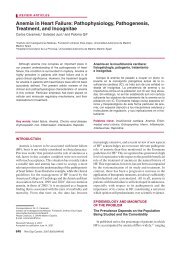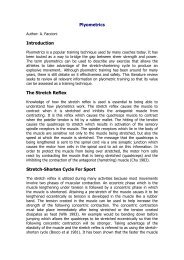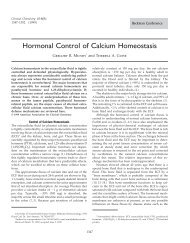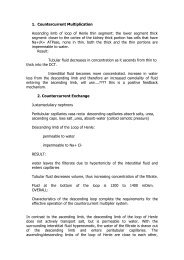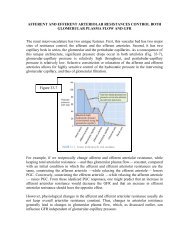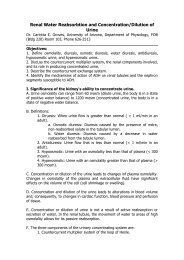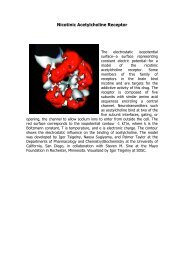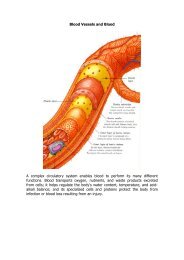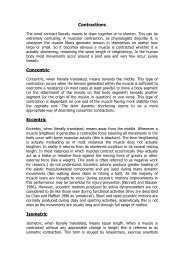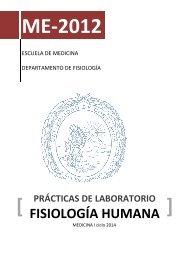Role of Gastrointestinal Hormones in the Proliferation of Normal and ...
Role of Gastrointestinal Hormones in the Proliferation of Normal and ...
Role of Gastrointestinal Hormones in the Proliferation of Normal and ...
Create successful ePaper yourself
Turn your PDF publications into a flip-book with our unique Google optimized e-Paper software.
Thomas et al. • <strong>Gastro<strong>in</strong>test<strong>in</strong>al</strong> <strong>Hormones</strong> <strong>and</strong> <strong>Proliferation</strong> Endocr<strong>in</strong>e Reviews, October 2003, 24(5):571–599 573basal processes, are visualized by immunohistochemistry <strong>in</strong><strong>the</strong> mucosa <strong>of</strong> <strong>the</strong> ileum, colon, <strong>and</strong> rectum (54).6. GLP. GLPs are a group <strong>of</strong> peptides known as <strong>the</strong> enteroglucagons.The enteroglucagons are products <strong>of</strong> <strong>the</strong> samegene that produces glucagon <strong>in</strong> <strong>the</strong> pancreatic -cell (3). The<strong>in</strong>test<strong>in</strong>al L cell produces two elongated glucagons, glicent<strong>in</strong><strong>and</strong> oxyntomodul<strong>in</strong>, <strong>and</strong> both <strong>of</strong> <strong>the</strong> enteroglucagons, GLP-1<strong>and</strong> GLP-2 (55). Both GLP-1 <strong>and</strong> GLP-2 have effects on nutrientabsorption <strong>and</strong> GI tract physiology; however, <strong>the</strong>setwo peptides have dist<strong>in</strong>ct roles. GLP-1 has a significanteffect on blood glucose levels, lower<strong>in</strong>g blood glucose levelsvia stimulation <strong>of</strong> <strong>in</strong>sul<strong>in</strong> secretion (55), thus suggest<strong>in</strong>g thatGLP-1 may provide some <strong>the</strong>rapeutic benefit to patients withdiabetes. GLP-2 displays m<strong>in</strong>imal effects on glucose levels,but demonstrates potent trophic effects on <strong>in</strong>test<strong>in</strong>al epi<strong>the</strong>lia(55).Both GLP-1 <strong>and</strong> GLP-2 are released when <strong>the</strong> L cell isexposed lum<strong>in</strong>ally to <strong>the</strong> products <strong>of</strong> a mixed meal (carbohydrateor fat) (55). L cells are most abundant <strong>in</strong> <strong>the</strong> mucosa<strong>of</strong> <strong>the</strong> ileum <strong>and</strong> colon; <strong>the</strong>y are <strong>the</strong> second most numerouspopulation <strong>of</strong> endocr<strong>in</strong>e cells <strong>in</strong> <strong>the</strong> human <strong>in</strong>test<strong>in</strong>e, afterenterochromaff<strong>in</strong> cells (56). Both GLP-1 <strong>and</strong> GLP-2 are rapidlycleaved by <strong>the</strong> exopeptidase dipeptidyl peptidase IV(55). Current concepts <strong>of</strong> L cell regulation <strong>in</strong>volve <strong>in</strong>tegration<strong>of</strong> hormonal messages from peptides, such as GRP <strong>and</strong> glucose-dependent<strong>in</strong>sul<strong>in</strong>otropic polypeptide, <strong>and</strong> neuronalcontrol (55).7. Somatostat<strong>in</strong>. Somatostat<strong>in</strong> was isolated <strong>and</strong> characterizedfrom ov<strong>in</strong>e hypothalamic tissue dur<strong>in</strong>g a search for a GHreleas<strong>in</strong>gfactor (57). S<strong>in</strong>ce <strong>the</strong> identification <strong>and</strong> purification<strong>of</strong> somatostation-14, precursor forms <strong>of</strong> greater molecularweight, <strong>in</strong>clud<strong>in</strong>g somatostat<strong>in</strong>-28, with somatostat<strong>in</strong>-14mak<strong>in</strong>g up <strong>the</strong> C term<strong>in</strong>us, <strong>and</strong> larger precursor forms <strong>of</strong> 120or more am<strong>in</strong>o acids have been identified (58). All <strong>of</strong> <strong>the</strong>sepeptides exert biological activity but differ <strong>in</strong> <strong>the</strong>ir relativepotency.Somatostat<strong>in</strong> has been detected <strong>in</strong> <strong>the</strong> nerves <strong>and</strong> cellbodies <strong>of</strong> <strong>the</strong> central <strong>and</strong> peripheral nervous systems, <strong>in</strong>clud<strong>in</strong>g<strong>the</strong> autonomic nervous system <strong>of</strong> <strong>the</strong> GI tract <strong>and</strong> <strong>the</strong>endocr<strong>in</strong>e-like D cells <strong>of</strong> <strong>the</strong> pancreatic islets <strong>and</strong> mucosa <strong>of</strong><strong>the</strong> stomach <strong>and</strong> <strong>in</strong>test<strong>in</strong>e (3). More than 90% <strong>of</strong> <strong>the</strong> somatostat<strong>in</strong>immunoreactivity <strong>in</strong> <strong>the</strong> human gut is located with<strong>in</strong><strong>the</strong> mucosal endocr<strong>in</strong>e D cells (58). In addition, somatostat<strong>in</strong>is located <strong>in</strong> <strong>the</strong> nerves <strong>of</strong> <strong>the</strong> myenteric plexus. Somatostat<strong>in</strong><strong>in</strong> <strong>the</strong> pancreas is located <strong>in</strong> <strong>the</strong> D cells at <strong>the</strong> periphery <strong>of</strong> <strong>the</strong>islets closely associated with <strong>the</strong> -cells (59).Somatostat<strong>in</strong> is a regulatory-<strong>in</strong>hibitory peptide, which, <strong>in</strong>contrast to BBS/GRP, may be considered as <strong>the</strong> universalendocr<strong>in</strong>e <strong>of</strong>f-switch. Somatostat<strong>in</strong> <strong>in</strong>hibits <strong>the</strong> release <strong>of</strong> GH<strong>and</strong> somatomed<strong>in</strong> C <strong>and</strong> all known GI hormones (3). Somatostat<strong>in</strong>also <strong>in</strong>hibits gastric acid secretion <strong>and</strong> motility, <strong>in</strong>test<strong>in</strong>alabsorption, <strong>and</strong> pancreatic bicarbonate <strong>and</strong> enzymesecretion, <strong>and</strong> selectively decreases splanchnic <strong>and</strong> portalblood flow (60). In addition, somatostat<strong>in</strong> can <strong>in</strong>hibit <strong>the</strong>growth <strong>of</strong> normal <strong>and</strong> neoplastic tissues (61–67).B. GI hormone receptors <strong>and</strong> signal transduction pathways1. Receptors. GI hormone-stimulated signal transduction occurswith <strong>the</strong> b<strong>in</strong>d<strong>in</strong>g <strong>of</strong> hormones to <strong>the</strong>ir cognate cell surfacereceptor, <strong>the</strong> G prote<strong>in</strong>-coupled receptor (GPCR) (68).The GI hormone-GPCRs have <strong>the</strong> typical structural features<strong>of</strong> G prote<strong>in</strong> b<strong>in</strong>d<strong>in</strong>g seven-transmembrane receptors (Fig. 1).The receptors for gastr<strong>in</strong>, CCK, BBS/GRP, NT, PYY, GLP-2,<strong>and</strong> somatostat<strong>in</strong>, which are respectively, <strong>the</strong> gastr<strong>in</strong>/CCK-Breceptor, CCK-A receptor, GRP receptor, <strong>the</strong> NT receptor(NTR), NPY receptor, GLP-2 receptor, <strong>and</strong> <strong>the</strong> somatostat<strong>in</strong>receptor (five subtypes), are all GPCRs (3, 55). GPCRs regulatea number <strong>of</strong> physiological processes, <strong>in</strong>clud<strong>in</strong>g proliferation,growth, <strong>and</strong> development (68). It was orig<strong>in</strong>allythought that, <strong>in</strong> order for GPCR signal<strong>in</strong>g to occur, specific<strong>in</strong>teractions between <strong>the</strong> GI hormone <strong>and</strong> <strong>the</strong> receptor werenecessary to produce conformational changes <strong>in</strong> <strong>the</strong> receptor<strong>and</strong> stimulate <strong>in</strong>tracellular signal transduction networks.However, recent studies suggest a more complex regulation<strong>of</strong> <strong>the</strong> GPCRs through: 1) dimerization with <strong>the</strong>mselves <strong>and</strong>o<strong>the</strong>r receptors; 2) activation <strong>of</strong> differ<strong>in</strong>g G prote<strong>in</strong>s; 3) <strong>in</strong>ternalization<strong>and</strong> desensitization; <strong>and</strong> 4) ability to change <strong>in</strong>conformation <strong>and</strong> <strong>in</strong>teractions with empty, or <strong>in</strong>active, receptors(69). It is suggested that this complicated mechanism<strong>of</strong> regulation allows peptides to <strong>in</strong>teract with GPCRs to stimulatediverse <strong>in</strong>tracellular signal<strong>in</strong>g pathways <strong>and</strong> ultimatelyaffect multiple physiological functions, depend<strong>in</strong>g on celltype.2. Signal transduction pathways. The seven transmembranespann<strong>in</strong>g-helical doma<strong>in</strong>s function as lig<strong>and</strong>-regulatedguan<strong>in</strong>e nucleotide exchange factors for <strong>the</strong> <strong>in</strong>tracellular heterotrimericG prote<strong>in</strong>s (68). Heterotrimeric G prote<strong>in</strong>s arecomposed <strong>of</strong> <strong>the</strong> products <strong>of</strong> three gene families encod<strong>in</strong>g -,-, <strong>and</strong> -subunits (68). The agonist-activated GPCR catalyzes<strong>the</strong> exchange <strong>of</strong> GTP for GDP bound to <strong>the</strong> G-subunit,as well as <strong>the</strong> dissociation <strong>of</strong> <strong>the</strong> GTP-G from its cognateG dimer (Fig. 2A) (68). The activated GTP-G- <strong>and</strong> Gsubunits,<strong>in</strong> turn, regulate <strong>the</strong> activity <strong>of</strong> various <strong>in</strong>tracellulareffector prote<strong>in</strong>s such as phospholipases, adenylyl cyclases,prote<strong>in</strong> k<strong>in</strong>ases, membrane ion channels, <strong>and</strong> members <strong>of</strong> <strong>the</strong>Ras family <strong>of</strong> GTP-b<strong>in</strong>d<strong>in</strong>g prote<strong>in</strong>s (68). In addition, basedon structural similarities, <strong>the</strong> 20 identified G-subunits havebeen divided <strong>in</strong>to four subfamilies <strong>and</strong> assigned an effectorpathway based on current evidence. The four are: 1) <strong>the</strong>cholera tox<strong>in</strong>-sensitive () subunits that stimulate adenylcyclase <strong>and</strong> <strong>in</strong>crease cAMP levels; 2) <strong>the</strong> pertussis tox<strong>in</strong>sensitive( i/o ) subunits that <strong>in</strong>hibit adenylyl cyclase activity;3) <strong>the</strong> pertussis tox<strong>in</strong>-<strong>in</strong>sensitive ( q/11/14 ) subunits that stimulatemembrane phospholipases; <strong>and</strong> 4) <strong>the</strong> 12/13 subfamilythat l<strong>in</strong>ks GPCR to <strong>the</strong> Ras-related GTP-b<strong>in</strong>d<strong>in</strong>g prote<strong>in</strong>, Rho(68). Additionally, 12 G- <strong>and</strong> 6-G subunits have been identified;<strong>the</strong>se -dimers have been l<strong>in</strong>ked to <strong>the</strong> signal<strong>in</strong>gmolecules phosphatidyl<strong>in</strong>ositol 3-k<strong>in</strong>ase (PI3K) <strong>and</strong> selectforms <strong>of</strong> adenylyl cyclase <strong>and</strong> receptor k<strong>in</strong>ases (68).Among <strong>the</strong> multiple <strong>in</strong>tracellular signal<strong>in</strong>g pathways thatmediate <strong>the</strong> proliferative effects <strong>of</strong> GPCRs, a family <strong>of</strong> relatedser<strong>in</strong>e-threon<strong>in</strong>e k<strong>in</strong>ases, collectively known as ERKs orMAPKs, appear to play a central role (70). After phosphorylationby <strong>the</strong>ir immediate upstream MAPK k<strong>in</strong>ase, members<strong>of</strong> <strong>the</strong> MAPK family translocate to <strong>the</strong> nucleus, where<strong>the</strong>y phosphorylate transcription factors, thus regulat<strong>in</strong>g <strong>the</strong>expression <strong>of</strong> genes that control growth (71). <strong>Hormones</strong> actas lig<strong>and</strong>s to eventually activate p42 <strong>and</strong> p44 MAPK (Fig. 2B)Downloaded from edrv.endojournals.org by on July 16, 2007



